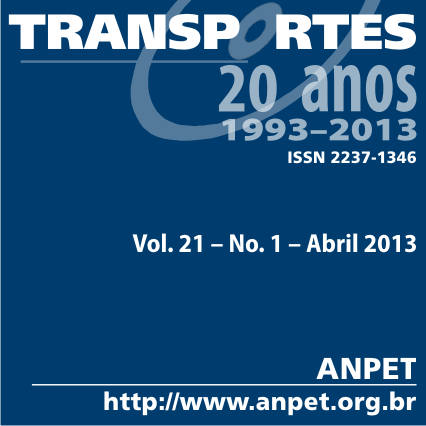Análise preliminar de parâmetros de fratura de concretos compactados com agregados de construção e de demolição para bases de pavimentos
DOI:
https://doi.org/10.4237/transportes.v21i1.674Abstract
Parâmetros de fratura para concretos secos que em sua fabricação empreguem agregados reciclados de resíduos de construção e de demolição foram avaliados, permitindo verificar que a resistência à propagação de fissuras bem como a energia total de fratura sofrem quedas relevantes em comparação aos mesmos concretos que empregam agregados virgens de granito. Os resultados sugerem cautela no emprego desses materiais em bases de pavimentos.
Downloads
References
Albuquerque, M.C.F.; Balbo, J.T.; Sansone, E.C.; Pinto, P.C. (2011) Fracture Characterization of Roller Compacted Concrete Mixtures with Blast Furnace Slag and Industrial Sand. Int. J. Pavement Res. Technol. 4(4), 244-25.
Balbo, J.T. (2006) Britas graduadas tratadas com cimento – uma avaliação de sua durabilidade sob o enfoque de porosidade, tenacidade e fratura. Transportes, ISSN 1415-7713, XIV (1), 45-53.
Bornhauser, A.; Kromp, K.; Pabst, R.F. (1985) R-curve evaluation with ceramic materials at elevated temperatures by an energy approach using direct observation and compliance calculation of the crack length, Journal of Materials Science 20, 2586-2596.
Cervo, T.T. (2004) Estudo do comportamento da fadiga de concretos de cimento para pavimentação. Tese (Doutorado), Escola Politécnica da Universidade de São Paulo.
Ferreira, L.E.T. (2007) Fracture analysis of a high-strength concrete and a high-strength steel-fiber-reinforced concrete. Mechanics of Composite Materials, 12, 479-486.
Irwin, G. R. (1957) Analysis of stresses and strain near the end of a crack. Journal of Applied Mechanics, 24, 361-364.
Kleinlein, F.W.; Hubner, H.R. (1997) Curve evaluation with ceramic materials at elevated temperatures by an energy approach using direct observation and compliance calculation of the crack length. In: Proceedings of ICF4, Waterloo, 3, 883.
Lemaistre, H. (1998) Study of the thermal-mechanics properties of several refractors. Thesis (PhD) École Doctorale Matériaux, Institut National de Sciences Appliquées.
Mazzei, A.C.A.; Rodrigues, J.A. (2000) Alumina-mulite-zirconia composites obtained by reaction sintering – Part II. R-Curve Behavior. Journal of Materials Science, 35, 2815-2824.
Nakayama. J. (1985) Direct measurement of fracture energies of brittle heterogeneous materials. Journal of American Ceramic Society, 48(11): 583-587.
Reinhardt, H.W.; Xu, S. (1999) Crack extension resistance base on the cohesive force in concrete. Engineering Fracture Mechanics 64 (5), 563-587.
Ricci, G. Balbo, J.T. (2009) Resistência e elasticidade de concretos compactados com agregados reciclados de construção e de demolição para aplicações em pavimentação. TRANSPORTES, v. XVII, n. 2, 27-35.
Sakai, M. (1987) Fracture Mechanics of Refractory Materials. Taikabutsu Overseas 8 (2), 4-12.
Salganik, R.L. (1965) The strength of adhesive joints using the theory of cracks. Int. Journal of Fracture Mechanics, 1, 114-128.
Saxena, P.; Tompkins D., Khazanovich, L. and Balbo J.T., 2010. Evaluation of characterization and performance modeling of cementitiously stabilized layers in MEPDG. Journal of the Transportation Research Board, Transportation Research Record, 2186, 111-119.
Downloads
Published
How to Cite
Issue
Section
License
Authors who submit papers for publication by TRANSPORTES agree to the following terms:
- The authors retain the copyright and grant Transportes the right of first publication of the manuscript, without any financial charge, and waive any other remuneration for its publication by ANPET.
- Upon publication by Transportes, the manuscript is automatically licensed under the Creative Commons License CC BY 4.0 license. This license permits the work to be shared with proper attribution to the authors and its original publication in this journal.
- Authors are authorized to enter into additional separate contracts for the non-exclusive distribution of the version of the manuscript published in this journal (e.g., publishing in an institutional repository or as a book chapter), with recognition of the initial publication in this journal, provided that such a contract does not imply an endorsement of the content of the manuscript or the new medium by ANPET.
- Authors are permitted and encouraged to publish and distribute their work online (e.g., in institutional repositories or on their personal websites) after the editorial process is complete. As Transportes provides open access to all published issues, authors are encouraged to use links to the DOI of their article in these cases.
- Authors guarantee that they have obtained the necessary authorization from their employers for the transfer of rights under this agreement, if these employers hold any copyright over the manuscript. Additionally, authors assume all responsibility for any copyright infringements by these employers, releasing ANPET and Transportes from any responsibility in this regard.
- Authors assume full responsibility for the content of the manuscript, including the necessary and appropriate authorizations for the disclosure of collected data and obtained results, releasing ANPET and Transportes from any responsibility in this regard.










